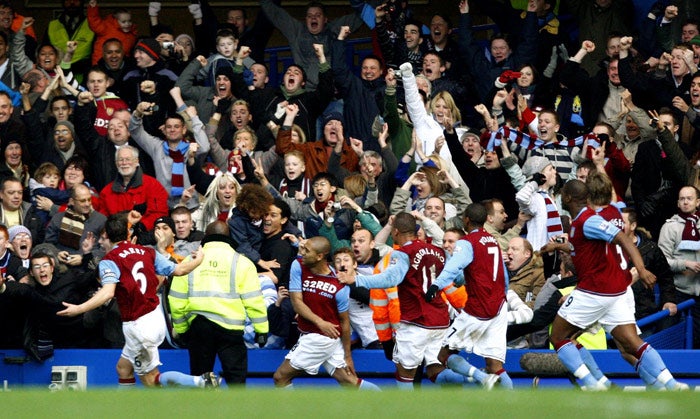Sold out? Premier League crowds set for 57-year high

Premier League crowds this season are on course to average more than 36,000 fans per match, the highest average gate per game in the top division since 1951, according to an Independent analysis of attendances.
Crowds in England's highest division grew steadily in the 1990s but reached a peak in the 2002-03 season with an average gate of 35,400 per game. Since then they have dropped slightly amid fears that high ticket prices and saturation TV coverage (among other reasons) might be permanently harming the popularity of the game. However, our research suggests the Premier League is on course for the highest average gates for 57 years. Sunderland's return to the top division has helped: they have attracted 42,695 people per game, an average gate only bettered by Manchester United, Arsenal, Newcastle and Liverpool. But the growth goes way beyond Wearside, with 17 of the Premier League's 20 clubs seeing either year-on-year rises or stable levels close to capacity.
The reasons are as varied as the clubs – ticket price initiatives, new facilities, a winning Swede at Manchester City, progress at Aston Villa – but the upward trend also reflects the increasing primacy of league football, for the clubs and their fans. With FA Cup fourth-round weekend approaching, only 11 Premier League clubs are still involved in that tournament, the lowest number at this stage since the Premier League began in 1992. The FA Cup also draws fewer people through the turnstiles. Thirteen Premier League clubs played a third-round match at home, and not a single one got a Cup gate higher than their average league gate. Five clubs saw drops, of between 30 and 40 per cent, compared with league gates.
Yet the Premier League's live audiences this season have been remarkable even by their own standards, and perhaps due to increased competition at both ends of the table. Whatever, current top-flight crowd levels are approaching double the numbers recorded at the nadir in the early 1980s, when hooliganism was rampant and fewer than 19,000 people watched each match.
With almost two-thirds of this season played, the average Premier League gate this season is 36,020. Manchester United have the highest average (75,612) and Wigan the lowest (18,515).
The three clubs with the biggest year-on-year rises are unsurprisingly those who played in the Championship last season: Sunderland's gates have leapt 51 per cent, Derby's are up 35 per cent and Birmingham's 25 per cent. But there have been sizeable hikes elsewhere, notably at Aston Villa (up 12 per cent), Manchester City (up nine per cent), Blackburn (up eight per cent) and even at ailing Fulham (up seven per cent). Some clubs have been unable to improve because they were virtual sellouts last year and still are (Manchester United, Arsenal), while Wigan, Newcastle and Tottenham are among others on the up, in the stands at least.
Only three clubs have seen falls, with Middlesbrough and Reading dropping by small numbers. Bolton are the biggest losers, down 13 per cent.
"There are three major reasons for the increases here," said a Manchester City spokesman. "Sven. Goran. And Eriksson." He added, rather more seriously, that City's "Live 4 City" ticket scheme, targeted at under-16s, has been a "huge success". Children can join free, and receive four free tickets, two before Christmas and two afterwards. Under-16s can also buy season tickets anywhere in the ground for £95. The spokesman said: "For the Liverpool game on 30 December, we had 7,400 under-16s at the game [among a gate of 47,321]. That's a record number, certainly since we started keeping these records in the 1980s."
At Villa Park, average league gates are up to 39,901, Villa's highest average for 58 years. "It's down to a combination of factors," a spokesman said. "Fundamentally, people are being drawn back by the football, the feel-good factor of Martin O'Neill, what he's building on the pitch, and Randy Lerner's chairmanship."
Villa pricing initiatives include various junior offers, and new reductions for students and the armed forces. Lerner, never one to blow his own trumpet, also deserves praise for heavy investment in facilities for the fans' benefit, and not necessarily ones that inflate his bottom line. The most significant was the multi-million pound refurbishment of the historic Holte Pub, now club-run as a restaurant and bar. On match days, it is run as a members-only hospitality venue, with the twist that groups of season-ticket holders are chosen to attend each week, partially at Lerner's expense.
Blackburn were among the first clubs to launch a drive to sell cut-price tickets, with the rationale that new TV income should be used to lower prices. It has worked, no doubt helped by a team doing well, although there is still more than 25 per cent of spare capacity on many match days.
Dan Johnson, the Premier League spokesman, said: "Price is a factor. Last season 16 Premier League clubs reduced or froze their prices, but equally important is the quality of the football. Many commentators have described this year's competition as one of the most open and compelling yet."
Join our commenting forum
Join thought-provoking conversations, follow other Independent readers and see their replies
Comments